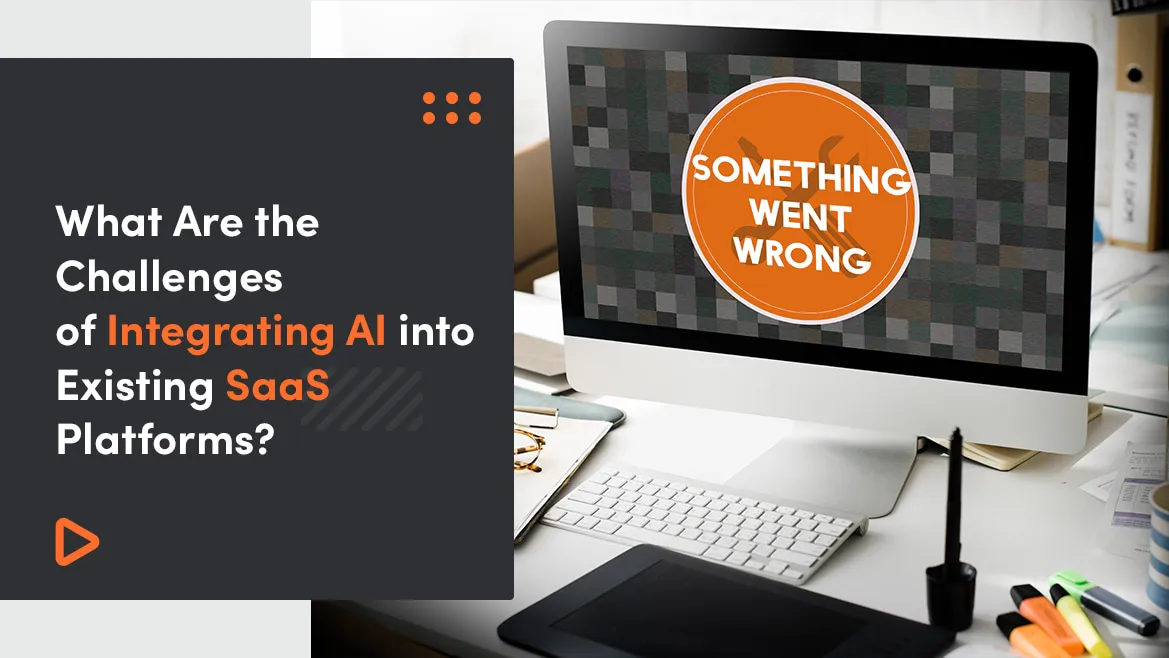As SaaS platforms continue to reshape industries and offer innovative solutions to ever-evolving customer needs, mastering the art of attracting new users while retaining existing ones has become imperative for sustained growth and success.
The acquisition of new customers signifies the continuous expansion of a SaaS company's reach and revenue potential. Conversely, churn poses a constant threat, akin to leaks in a vessel that must be swiftly sealed.
Businesses often prioritize acquiring new customers over retaining current ones, driven by the excitement of expanding their customer base. However, this strategy comes at a considerable cost - it takes 5 times more resources to acquire a new customer than it does to keep an existing one. While the focus on acquisition may provide momentary satisfaction, the neglect of current customers can have long-lasting consequences.
Recognizing the significance of these interrelated dynamics is essential. The process of acquiring new customers breathes life into a SaaS enterprise, driving revenue, market visibility, and brand recognition. Yet, neglecting the issue of churn can unravel even the most promising growth strategies.
According to CallMiner, companies lose $35.3 billion annually due to customer churn, yet more than two out of three businesses lack a strategy to prevent customer churn.
So, why is this balance between customer acquisition and churn reduction so critical? In this guide, we will explore some of the best strategies to help you strike the perfect balance and optimize your SaaS platform's performance.
What you will learn from this article:
- How to reduce churn
- How to calculate churn in your SaaS platform
- 4 essential factors for a successful customer acquisition strategy
- The challenge of customer balance in SaaS software development
- What is the influence of AI on SaaS platforms?
- Top effective tools to help you reduce churn in your saas platform in 2023
- How a mobile app can help reduce churn
How Do You Calculate Churn in Your Saas Platform?
Calculating churn in a Software as a Service (SaaS) platform is essential for understanding customer retention and the overall health of your business. And to gain a comprehensive understanding of how your SaaS platform is performing, it’s crucial to track both user/customer churn and revenue churn. Let's dive deeper into these two types of churn:
User/Customer Churn Calculation:
User/customer churn measures the percentage of customers you lose over a specific period. To calculate it, use the formula:
Customer Churn Rate = [(Customers at the Beginning of the Period - Customers at the End of the Period) / Customers at the Beginning of the Period] * 100
For example, let’s assume the number of paying customers you had in January 2023 is 2,400, but that number was reduced to 1,800 in February 2023 with no new customers added.
Customer Churn Rate = [(2,400 - 1,800) / 2,400] 100 = (600 / 2,400) 100 = 25%
So, the customer churn rate for the month is 25%.
Revenue Churn Calculation:
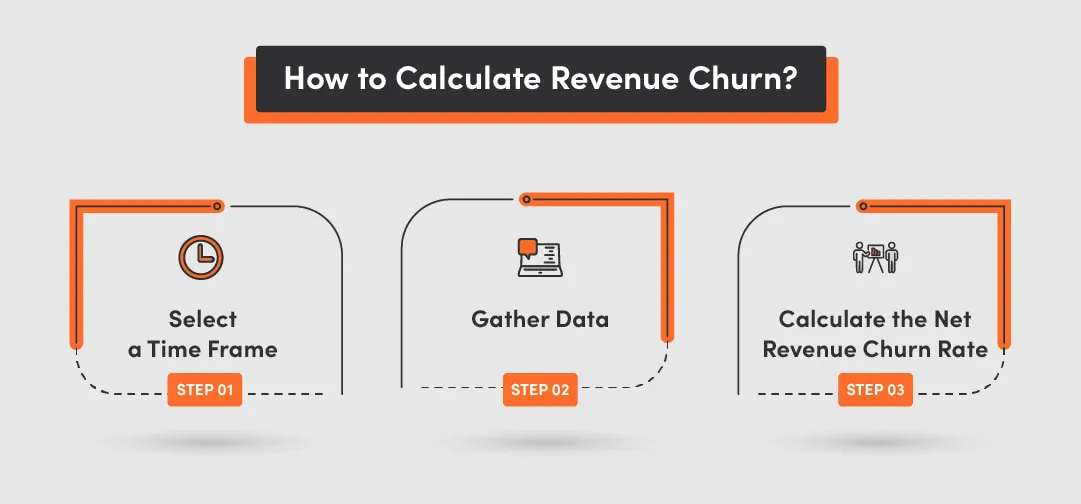
Revenue churn measures the amount of lost revenue over a given period, typically due to customers downgrading or not renewing their subscriptions. To calculate the net revenue churn rate, follow these steps:
Step 1: Select a Time Frame
Choose the time frame for which you want to calculate revenue churn. For example, you might
want to calculate for a year, say from January 2023 to December 2023.
Step 2: Gather Data
Collect data on the total revenue at the beginning and end of the selected period.
For example, suppose your Monthly Recurring Revenue (MRR) at the beginning of January 2023 was $120,000, and at the end of December 2023, it was $90,000.
Step 3: Calculate the Net Revenue Churn Rate
To calculate the net revenue churn rate, use the formula:
Net Revenue Churn Rate = [(Total Revenue at the Beginning - Total Revenue at the End) / Total Revenue at the Beginning] * 100
Net Revenue Churn Rate = [($120,000 - $90,000) / $120,000] 100 = ($30,000 / $120,000) 100 = 25%
So, your revenue churn rate for the year is also 25%.
Both user/customer churn and revenue churn rates are at 25% for the month of February 2023. This means that not only did you lose 25% of your customers, but you also lost 25% of your recurring revenue during that period.
It's essential to track both types of churn separately to understand how customer loss is impacting your revenue.
10 Ways to Reduce Customer Churn in Your SaaS Business
If you're running a SaaS business, you're likely familiar with the challenges of customer churn. However, by implementing the right strategies and approaches, you can effectively reduce customer churn and boost customer retention. Let’s explore 10 effective ways to achieve this in a SaaS platform:
Improving the Onboarding Process
The first step to reducing customer churn is ensuring that your customers have a smooth and seamless onboarding experience. Provide comprehensive tutorials, demos, and guides to help them get started with your SaaS product.
Adding Value to Your Product
Continuously enhance your product by adding new features and functionalities that address customer needs and pain points. Regularly communicate these updates to your users to remind them of the value your product provides.
Implementing Rewards Programs
Reward loyal customers with exclusive offers, discounts, or access to premium features. Incentives can encourage customers to remain subscribed and engaged with your service.
Monitoring Customer Health Scores
Develop a customer health scoring system to identify users at risk of churning. Factors like usage frequency, support tickets, and feature adoption can be used to assess a customer's health. Address issues promptly for those with low scores.
Paying Attention to High-Value Customers
High-value customers are the lifeblood of your SaaS business. Provide them with personalized support, early access to new features, and exceptional service to keep them satisfied.
Investing in Customer Success
Allocate resources to a dedicated customer success team. They can proactively engage with customers, offer personalized support, and help them get the most out of your software.
Leveraging Surveys and Customer Feedback
Regularly collect feedback from your customers through surveys and direct communication. Use this data to identify pain points, gather feature requests, and address concerns, demonstrating that you value their input.
Utilizing Churn Analytics Software
Implement churn analytics tools to track and analyze customer churn patterns. These tools can help you uncover trends and insights that enable you to take proactive measures to reduce churn.
Reviewing Pricing Strategy and Subscription Options
Periodically evaluate your SaaS pricing strategy and subscription options. Ensure your pricing aligns with the value you provide and consider offering flexible plans to accommodate a variety of customer needs.
Building a Personalized Cancellation Flow
Even when customers decide to cancel, you can salvage the relationship by offering personalized options, such as pausing their subscription or providing a temporary discount.
Try our developers.
Free for 2 weeks.
No risk. Just results. Get a feel for our process, speed, and quality — work with our developers for a trial sprint and see why global companies choose Selleo.
4 Essential Factors for a Successful Customer Acquisition Strategy
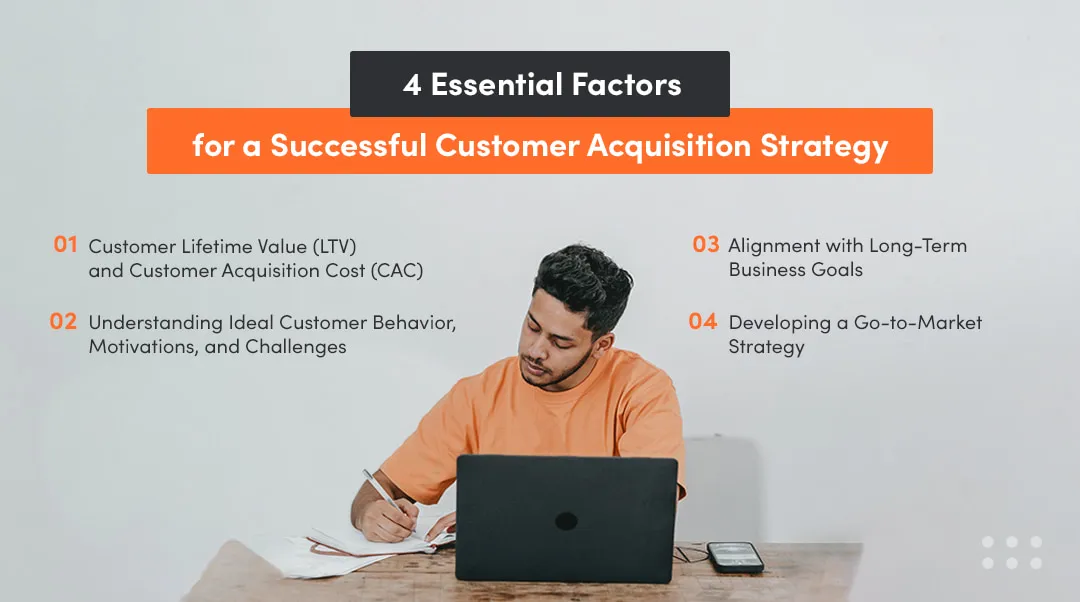
A well-crafted customer acquisition strategy is vital for the growth and sustainability of any business. To ensure your strategy is effective, you must consider four essential factors and evaluate them rigorously:
Customer Lifetime Value (LTV) and Customer Acquisition Cost (CAC)
Customer Lifetime Value (LTV): LTV represents the total revenue a customer is expected to generate throughout their entire relationship with your business. Calculating LTV involves estimating the average purchase value, purchase frequency, and customer lifespan.
On the other hand, Customer Acquisition Cost (CAC) is the expense incurred to acquire a new customer. It encompasses marketing, sales, and other associated costs.
Example: Suppose you operate a project management SaaS platform. On average, a customer subscribes for 24 months, paying $50 per month. Your LTV calculation is LTV = $50 (monthly spend) * 24 (months) = $1200.
Now, let's say your recent marketing campaign cost $10,000 and acquired 200 new customers. Your CAC is CAC = $10,000 (campaign cost) / 200 (new customers) = $50 per customer.
In this example, your LTV ($1200) is significantly higher than your CAC ($50), indicating a healthy acquisition strategy. Regularly monitor these metrics, and if your CAC starts nearing or exceeding your LTV, it's a red flag, and adjustments to your strategy may be needed.
Understanding Ideal Customer Behavior, Motivations, and Challenges
Understanding your ideal customers is paramount. You need to delve into their behaviors, motivations, and challenges to create tailored acquisition strategies.
For example, suppose your SaaS business offers accounting software for small businesses. After conducting surveys and analyzing data, you discover that your ideal customers, small business owners, are motivated by the desire to simplify their financial processes. They often face challenges related to bookkeeping errors and compliance issues.
Recognize the pain points and challenges, and then tailor your acquisition strategy by emphasizing how your software streamlines accounting, reduces errors, and ensures compliance. Your marketing messages should directly address these motivations and challenges, resonating with your ideal customers.
Alignment with Long-Term Business Goals
Your acquisition strategy should align seamlessly with your SaaS business's long-term goals. Clearly define your business's long-term goals, whether it's achieving a certain number of users, expanding into new markets, or generating a specific revenue target.
Ensure that your customer acquisition strategy is designed to support and drive progress toward these long-term goals. Consider how each acquisition channel or tactic contributes to the bigger picture.
Regularly assess your progress toward your long-term goals. Adjust your acquisition strategy if you find misalignment or if certain channels or tactics are not effectively driving you closer to those objectives.
Developing a Go-to-Market Strategy
Your go-to-market strategy outlines how you plan to reach and engage your target audience effectively. It involves marketing channels, messaging, and tactics.
Determine the most suitable channels for reaching your audience. This might include content marketing, social media advertising, email marketing, partnerships, or direct sales. Consider the preferences and behavior of your ideal customers.
SaaS Platforms Customer Acquisition Tactics and Strategies
Successful customer acquisition in the SaaS industry requires a well-defined strategy that spans the entire customer acquisition funnel. From lead generation to lead nurturing and sales, each stage demands careful planning and execution.
Lead generation is the initial stage where potential customers are identified and brought into the sales funnel. It's crucial to create a steady stream of qualified leads to ensure a healthy sales pipeline.
Once leads are generated, it's essential to nurture them through the sales funnel and build relationships with them.
The final stage is converting nurtured leads into paying customers. Key tactics for sales conversion include personalized sales outreach, free trials, and freemium models, customer support, customer success programs, and a/b testing and optimization.
The following are some of the key tactics and strategies that SaaS businesses can employ to bolster their customer acquisition efforts:
Content Marketing
Content marketing is a cornerstone of customer acquisition for SaaS companies. By consistently producing high-quality blog posts, ebooks, webinars, and other content, you can establish your authority in your niche. Potential customers often turn to educational resources when searching for solutions, and this is your opportunity to provide value and build trust.
Social and Display Ads
Social and display ads allow SaaS businesses to target specific demographics and interests on platforms like Facebook, LinkedIn, and Google Ads. These platforms offer powerful tools to reach potential customers who are actively seeking solutions or may have expressed interest in similar products.
SEM and SEO
Search engine marketing (SEM) and search engine optimization (SEO) play vital roles in enhancing a SaaS company's online visibility. SEM involves paid advertising on search engines, allowing your SaaS product to appear prominently in search results. On the other hand, SEO focuses on optimizing your website's organic search rankings, ensuring that it appears near the top of search results without paid promotion.
Email Marketing
By building an email list of leads and nurturing them through personalized email campaigns, you can guide potential customers through the buyer's journey. Offering informative newsletters, product updates, and exclusive offers can incentivize recipients to take action and subscribe to your SaaS product.
Referral Programs
Encourage your existing customers to refer friends, colleagues, or other businesses in exchange for rewards or discounts. SaaS products often rely on word-of-mouth recommendations, and referral programs provide a structured way to harness this powerful marketing channel.
Freemium Products, Free Trials, and Demos
Offering freemium products, free trials, and demos is a proven method to allow potential customers to experience your SaaS product firsthand. This hands-on experience can effectively showcase the value and functionality of your software. It provides a risk-free opportunity for potential customers to explore your product and ultimately make an informed decision to subscribe.
The Challenge of Customer Balance in SaaS Software Development
In this section, we will delve into this challenge, explore case studies, and provide examples from popular SaaS applications like Slack and HubSpot to illustrate how they manage this delicate balance.
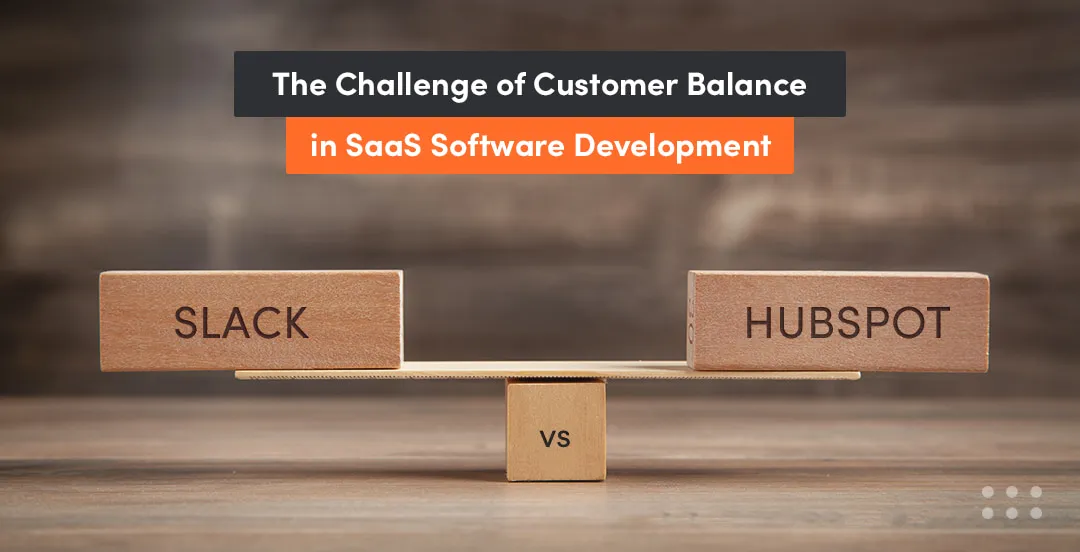
Slack: Word-of-Mouth Marketing
Slack's journey to becoming one of the most popular collaboration tools in the SaaS world is a testament to the power of word-of-mouth marketing and its impact on customer acquisition and retention. Slack's success story is characterized by its unique approach to building a harmonious and satisfied user community, which significantly achieved over 10 million daily active users.
Instead of pouring vast amounts of money into traditional advertising, Slack focused on creating a product so remarkable, including in-app invitations and intuitive and user-friendly, that users would organically spread the word to their colleagues and friends.
Hubspot: The Power of Inbound Marketing
HubSpot consistently creates and distributes high-quality content, including ebooks, blogs, templates, webinars, and more, covering every aspect of inbound marketing and sales. By freely sharing this valuable knowledge, HubSpot positioned itself as a trusted source of expertise in the industry.
Additionally, HubSpot's onboarding process is known for its excellence. They offer comprehensive training, support, and resources to help new users get started quickly and effectively. This ensures that customers can see the value of HubSpot's offerings early on, increasing the likelihood of retention.
Through these strategic approaches, along with its innovative tools, HubSpot has attracted a vast audience and retained a substantial customer base, with over 180,000 clients to their name.
The Impact of AI on SaaS Sales Success
AI influence on SaaS platforms is far-reaching, offering innovative solutions to optimize sales conversations, reduce customer churn, improve customer acquisition, and enhance overall customer experiences. Let’s explore the profound influence of AI on SaaS platforms and its transformative role in sales success.
Optimizing Sales Conversations & Follow-ups
One of the most significant ways AI is reshaping SaaS sales success is by optimizing sales conversations and follow-ups.
AI algorithms analyze user behavior and preferences to offer personalized product recommendations. This not only enhances the customer's shopping experience but also increases the likelihood of upselling or cross-selling.
Additionally, by analyzing historical data and patterns, AI can predict when a customer might cancel their subscription. This allows sales teams to intervene with targeted offers or support, significantly reducing churn rates.
Furthermore, AI-driven chatbots provide immediate assistance, answer frequently asked questions, and guide users through troubleshooting processes. When customers receive prompt and accurate assistance, they are more likely to remain satisfied and less likely to churn. These systems can also send timely follow-up messages, answer common queries, and nurture leads, all without human intervention.
Data-driven Coaching & CRM Management
AI's impact on SaaS sales success extends beyond customer interactions to include data-driven coaching and Customer Relationship Management (CRM) management.
AI can analyze sales representatives' performance data to identify strengths and weaknesses. It can track key performance indicators (KPIs) and provide actionable insights to improve individual and team performance.
AI also automates many CRM tasks, such as data entry and lead prioritization. This automation ensures that sales teams are always working with up-to-date information and focusing their efforts on leads with the highest conversion potential. As a result, the sales process becomes more efficient, and customer acquisition rates increase.
Additionally, AI-driven lead scoring systems assign scores to leads based on their likelihood to convert. This aids sales teams in prioritizing their efforts on leads with the highest conversion potential. As a result, valuable time and resources are focused where they matter most.
Enhanced Customer Experience
AI plays a pivotal role in enhancing the overall customer experience in SaaS sales.
AI-powered chatbots provide round-the-clock customer support, ensuring that customers can get assistance whenever they need it. This availability improves customer satisfaction and fosters loyalty.
In addition, AI enables SaaS companies to send personalized communication to customers. Whether it's tailored emails, in-app messages, or notifications based on user behavior, personalized communication makes customers feel valued and engaged, ultimately reducing churn rates.
Furthermore, an AI-powered system can guide new customers through the onboarding process, making it seamless and user-friendly. When customers have a positive onboarding experience, they are more likely to stay engaged and continue using the SaaS product.
Can You Reduce Churn With a Mobile App?
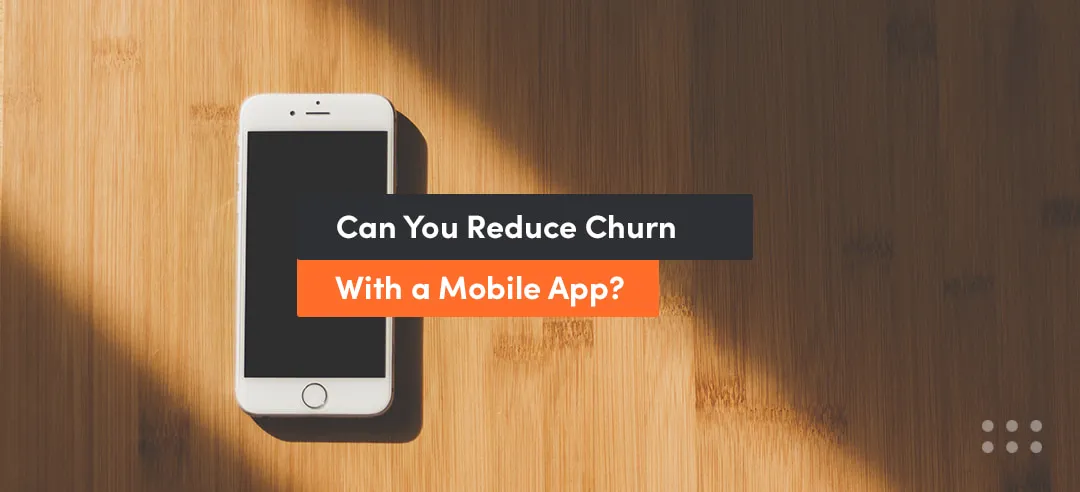
Certainly, a well-designed mobile app can be a powerful tool to increase engagement, boost customer loyalty, and create a better user experience, all of which contribute to reducing churn. Let’s look at how you can achieve that:
- Send relevant updates in real-time
By utilizing push notifications, you can keep your customers informed about the latest products, promotions, and news related to your business. This instant communication not only keeps your brand fresh in their minds but also increases their engagement.
- Include exclusive mobile features and functions
Take advantage of the unique capabilities of mobile devices to create features and functions that are only possible on mobile. Examples include using GPS for location-based services, camera integration for augmented reality experiences, or mobile payment options for seamless transactions. By offering features that can't be replicated on other platforms, you incentivize users to stay loyal to your app.
- Design a better user experience
Prioritize user experience (UX) by designing an intuitive, user-friendly interface. Easy navigation, clear layouts, and efficient functionality create a positive user experience, leaving a lasting impression and increasing the likelihood of customer retention.
- Incorporate gamification elements
Incorporating gamification elements into your mobile app, such as rewards, badges, and challenges, can make interacting with your brand more enjoyable. Users who find your app engaging and fun are more likely to remain loyal customers.
For example, Gmail, the popular email service by Google, serves as an excellent case study in churn reduction through a mobile app. The Gmail mobile app offers a range of features that make it a preferred choice for users:
- Intuitive interface: The app's user-friendly interface makes it easy for users to manage their emails on mobile devices.
- Offline access: Users can access their emails even without an internet connection, ensuring uninterrupted service.
- Push notifications: Gmail's app sends real-time notifications, keeping users engaged with their emails.
What Tools Can Help You Reduce Churn in Your Saas Platform in 2023?
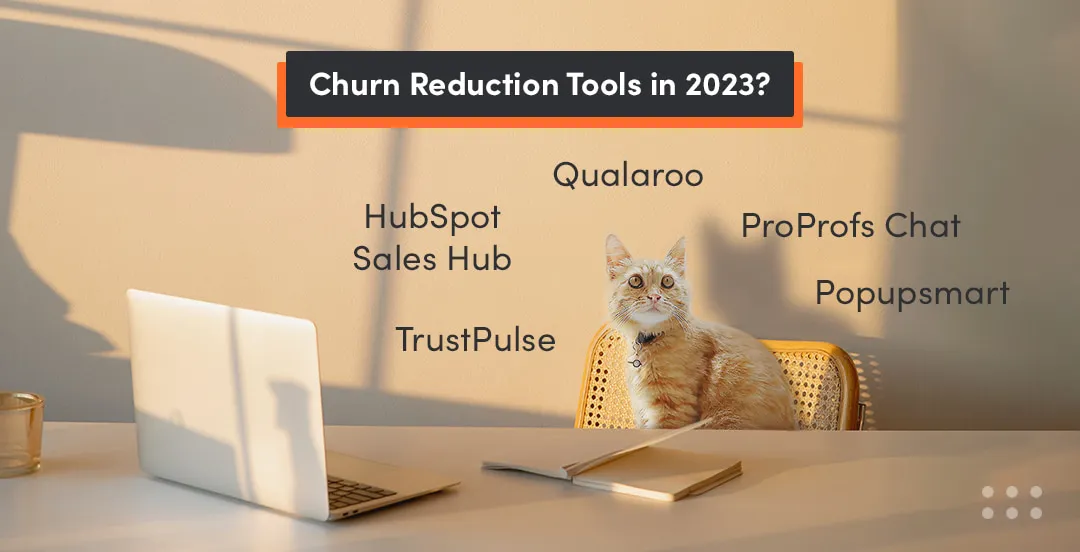
In 2023, reducing churn in a SaaS platform remains a critical goal for many businesses. Fortunately, there are tools available to help you tackle this challenge effectively. Let's dive into the top 5 tools that can help in reducing churn on your SaaS platform.
HubSpot Sales Hub
HubSpot Sales is a powerful Customer Relationship Management (CRM) platform with a wide array of sales engagement tools, reporting, and analytics features. It is designed to streamline your sales processes, enhance customer interactions, and boost your business's overall performance.
Key Functionalities
- Streamlines the automation of follow-up and promotional emails.
- Analyze customer interactions and feedback to make data-driven decisions.
- Facilitates training via the HubSpot Academy.
- Offers a centralized hub for marketing analytics.
- Syncs advertisements across multiple platforms from a single location.
Limitations
- Users may need some time to become fully proficient with the software.
- The pricing structure may not be cost-effective for everyone.
- At times, the workflow automation within HubSpot can be sensitive and may result in occasional bugs or unexpected behavior.
TrustPulse
TrustPulse stands out as a sophisticated social proof application tailored for marketing agencies, bloggers, eCommerce websites, and small businesses alike. If your goal is to enhance your website's conversion rates, mitigate cart abandonment, and ultimately boost your sales figures, TrustPulse is the ideal solution for you.
Key Functionalities
- Monitors conversion analytics.
- Provides real-time visitor tracking.
- Identifies purchases, signups, and more.
- Facilitates the display of social proof.
- Builds notifications in less than 5 minutes.
Limitation
- Limited integration options
- Some users may find TrustPulse to be somewhat expensive for an app with its specific features and capabilities.
Qualaroo
Qualaroo is a valuable customer acquisition tool worth considering for your business. As feedback software, Qualaroo facilitates the evaluation of customer sentiments. It employs Watson Sentiment Analysis to monitor mood metrics derived from keywords used by customers in their feedback. Additionally, Qualaroo provides a dedicated reports section that offers comprehensive insights through an in-depth analysis of customer feedback.
Key Functionalities
- Provides AI-driven sentiment analysis.
- Assists in setting Nudge.
- Enables A/B testing capabilities.
- Offers question branching functionality.
- Generates NPS and exit-intent surveys.
Limitations
- Qualaroo's Nudge feature, which encourages customers to provide feedback, is useful. However, it has a limitation where desktop Nudges cannot be utilized or duplicated for mobile Nudges.
ProProfs Chat
ProProfs Chat is a powerful tool that facilitates real-time customer engagement. It serves as an invaluable customer-centric tool, with live chat features designed to empower your sales and support teams to instantly connect and interact with website visitors in real-time. Moreover, you can initiate meaningful conversations with customers by leveraging personalized messages, enhancing their overall experience.
Key Functionalities
- Utilizes chatbots for automation.
- Keeps visitors informed through announcements.
- Automatically directs and routes visitors.
- Actively engages visitors with proactive chats.
- Provides seamless integration with marketing and sales platforms.
Limitations
- Most essential features are available only to premium users which might not be cost-effective for budget-conscious users.
Popupsmart
Popupsmart is an intuitive no-code popup builder that empowers you to boost your sales conversions and enhance visitor engagement. Additionally, it offers a range of features that simplify and enhance the process of creating popups, making them more user-friendly and effective.
Key Functionalities
- Facilitate social sharing
- Collect feedback & surveys
- Increase user engagement
- Make announcement
- Gamify your campaign
Limitations
- It does not support multi-language popups.
- At present, there is no A/B testing functionality available.
Summary
SaaS platforms need to master customer acquisition and churn reduction for sustained growth and success. As we've explored in this article, these strategies are not merely beneficial but essential for long-term growth.
Customer acquisition acts as the lifeblood of your SaaS enterprise, expanding your reach, boosting revenue, and elevating brand recognition. However, it should not overshadow the equally critical task of reducing churn. Neglecting churn can unravel even the most promising growth plans, as elevated churn rates not only hinder expansion but also incur steep customer acquisition costs, making it more expensive to replace lost clients than to retain them.
It's essential to recognize the magnitude of these interrelated dynamics, given that businesses lose a staggering $35.3 billion annually due to avoidable customer churn. Astonishingly, more than two-thirds of businesses lack a strategy to tackle this problem effectively.
However, the path to addressing these challenges is not a solitary journey. Businesses have a plethora of tools and apps at their disposal to streamline customer acquisition and churn reduction efforts. Moreover, if your SaaS platform has unique requirements, custom solutions can be developed to address your specific needs.
In essence, in your pursuit of success in the SaaS industry, remember that the twin pillars of customer acquisition and churn reduction are the keys to your long-term prosperity. Adopt these strategies, utilize available resources, and avoid the pitfalls that have cost other companies dearly. Your commitment to these principles will not only safeguard your bottom line but also propel your business toward sustained growth and success.




